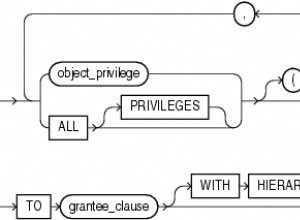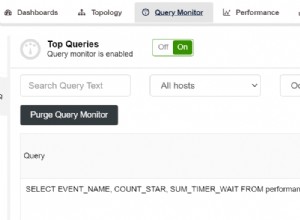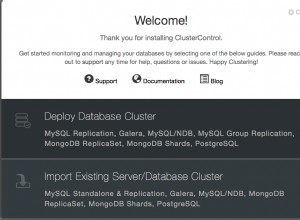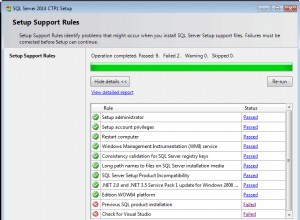Non utilizzare un trigger per questo. La maggior parte delle condizioni che hai codificato negli IF nidificati (del tuo trigger) può probabilmente essere eseguita tramite vincoli di chiave esterna e vincoli di controllo. Inoltre, non è necessario memorizzare la 'X' per WOMAN_ACT da nessuna parte, poiché è un "valore derivato", ovvero puoi ottenerlo o generarlo quando esegui query sui tuoi dati. Forse il seguente esempio (basato sulle tabelle e sui dati originali) ti aiuterà a trovare una soluzione. Si prega di leggere i commenti nel codice.
Codice DDL
create table person (
id number primary key
, registration_number varchar2(9) unique
, primary_number varchar2(9)
-- , women_act varchar2(1) <- not needed!
);
create table consolidated_numbers (
secondary_number varchar2(9) references person( registration_number )
, person_id number references person( id )
);
create table code (
valid_code varchar2(2) primary key
);
-- CHECK constraint added to allow only certain TYPE_IDs
create table history_transaction (
reason varchar2(2) references code( valid_code ) -- valid REASONSs enforced by FK constraint
, person_id number references person( id )
, type_id number check (
type_id in (
120, 140, 1420, 1440, 160, 180, 150, 1520, 1540, 1560 -- only allow these type_ids
)
)
, action_date date
);
Dati di prova
-- INSERT your initial test data
begin
insert into person (ID,registration_number,primary_number) values(132, '000000001', null);
insert into person (ID,registration_number,primary_number) values (151, '000000002', '000000001');
insert into consolidated_numbers (SECONDARY_NUMBER,person_id) values ('000000002', 132);
insert into code (valid_code) values ('A1');
insert into code (valid_code) values ('T1');
insert into code (valid_code) values ('N2');
insert into history_transaction (reason,person_id,type_id,action_date)
values ('A1', 132, 1420, DATE '2019-01-01');
commit ;
end;
/
La seguente VIEW raccoglierà gli ID_persona dalle tabelle HISTORY_TRANSACTION, aggiungerà una "X" a ognuno di essi e raccoglierà anche tutte le persone che sono "associate" a (o:mappate a) questi ID da CONSOLIDATED_NUMBERS, e aggiungerà anche un 'X' ai loro ID. (Nota a margine:sembra che la tua tabella PERSON contenga una relazione ricorsiva, quindi si potrebbe scrivere una query ricorsiva. Tuttavia, avrai un motivo per modellare la tabella CONSOLIDATED_NUMBERS, quindi useremo un JOIN qui.)
VISUALIZZA
create or replace view personx
as
with PID as (
select distinct person_id
from history_transaction
)
select person_id, 'X' as woman_act -- [Q1] all person_ids from history_transaction
from PID
union
select P.id, 'X' as woman_act -- [Q2] all person_ids associated with ids from Q1
from person P
join consolidated_numbers C
on P.registration_number = C.secondary_number
and C.person_id in (
select person_id from PID
)
;
-- with your initial test data, we get:
select * from personx ;
+---------+---------+
|PERSON_ID|WOMAN_ACT|
+---------+---------+
|132 |X |
|151 |X |
+---------+---------+
Ora rimuoviamo/aggiungiamo alcuni dati ed eseguiamo alcuni test (vedi anche:DBfiddle ):
-- test 1
delete from history_transaction ;
select * from personx ;
-- result: no rows selected -> OK
-- test 2
insert into history_transaction (reason,person_id,type_id,action_date)
values ('A1', 132, 1420, DATE '2019-01-01');
select * from personx ;
+---------+---------+
|PERSON_ID|WOMAN_ACT|
+---------+---------+
|132 |X |
|151 |X |
+---------+---------+
-- test 3: add more associations
begin
-- new: person 345 associated with person 132
insert into person (ID,registration_number,primary_number) values (345, '000000345', '000000001');
insert into consolidated_numbers (SECONDARY_NUMBER,person_id) values ('000000345', 132);
commit ;
end ;
/
select * from personx ;
+---------+---------+
|PERSON_ID|WOMAN_ACT|
+---------+---------+
|132 |X |
|151 |X |
|345 |X |
+---------+---------+
Un altro test prima di entrare più nel dettaglio:
-- test 4
-- add more associations
-- no entry in history_transactions for person(id) 1000
begin
insert into person (ID,registration_number,primary_number) values(1000, '000000777', null);
insert into person (ID,registration_number,primary_number) values (2000, '000000778', '000000777');
insert into consolidated_numbers (SECONDARY_NUMBER,person_id) values ('000000778', 1000);
commit ;
end ;
/
-- output must be the same as before -> result OK
select * from personx ;
+---------+---------+
|PERSON_ID|WOMAN_ACT|
+---------+---------+
|132 |X |
|151 |X |
|345 |X |
+---------+---------+
ISCRIVITI la vista alla tabella delle persone
-- test 5
-- add an entry from person 1000 into the history_transaction table
insert into history_transaction (reason,person_id,type_id,action_date)
values ('N2', 1000, 1420, sysdate);
select * from personx ;
+---------+---------+
|PERSON_ID|WOMAN_ACT|
+---------+---------+
|132 |X |
|151 |X |
|345 |X |
|1000 |X |
|2000 |X |
+---------+---------+
-- test 5: show more details
select P.id, P.registration_number, P.primary_number, PX.woman_act
from personx PX right join person P on PX.person_id = P.id ;
+----+-------------------+--------------+---------+
|ID |REGISTRATION_NUMBER|PRIMARY_NUMBER|WOMAN_ACT|
+----+-------------------+--------------+---------+
|132 |000000001 |NULL |X |
|151 |000000002 |000000001 |X |
|345 |000000345 |000000001 |X |
|1000|000000777 |NULL |X |
|2000|000000778 |000000777 |X |
+----+-------------------+--------------+---------+
Il join esterno è necessario per PERSON_ID che non hanno righe corrispondenti nella tabella HISTORY_TRANSACTION es.
-- test 6
-- add more associations
-- no entry in history_transactions for person(id) 10000!
begin
insert into person (ID,registration_number,primary_number) values(10000, '000007777', null);
insert into person (ID,registration_number,primary_number) values (20000, '000007778', '000007777');
insert into consolidated_numbers (SECONDARY_NUMBER,person_id) values ('000007778', 10000);
commit ;
end ;
/
-- after TEST 6 data have been inserted:
select P.id, P.registration_number, P.primary_number, PX.woman_act
from personx PX right join person P on PX.person_id = P.id ;
+-----+-------------------+--------------+---------+
|ID |REGISTRATION_NUMBER|PRIMARY_NUMBER|WOMAN_ACT|
+-----+-------------------+--------------+---------+
|132 |000000001 |NULL |X |
|151 |000000002 |000000001 |X |
|345 |000000345 |000000001 |X |
|1000 |000000777 |NULL |X |
|2000 |000000778 |000000777 |X |
|20000|000007778 |000007777 |NULL |
|10000|000007777 |NULL |NULL |
+-----+-------------------+--------------+---------+
MODIFICA
Se - come affermato nel tuo commento - devi memorizzare un valore nella colonna WOMAN_ACT (sebbene apparentemente sia un "valore derivato"), potresti scrivere un pacchetto che contenga procedure per tutte le operazioni DML richieste, sempre senza utilizzare un trigger. Tuttavia, senza conoscere la storia completa è difficile decidere se questo sarebbe il modo migliore per andare avanti. L'esempio seguente utilizza un piccolo pacchetto contenente procedure per impostare i valori WOMAN_ACT della tabella PERSON e un trigger che si attiva dopo INSERT/UPDATE (tabella:HISTORY_TRANSACTIONS). DBfiddle qui .
Tabella PERSON
create table person (
id number primary key
, registration_number varchar2(9) unique
, primary_number varchar2(9)
, woman_act varchar2(1) check ( woman_act in ( null, 'X' ) )
);
-- all other tables: same as before
PACCHETTO
create or replace package pxpkg
is
-- find out whether a certain id (table: PERSON) is a "parent" or a "child"
function isparent( id_ number ) return boolean ;
-- set 'X' values: id_ is a "parent"
procedure setx_parentchildren( id_ number ) ;
-- set 'X' values: id_ is a "child"
procedure setx_childsiblings( id_ number ) ;
end pxpkg ;
/
CORPO DEL PACCHETTO
create or replace package body pxpkg
is
function isparent( id_ number )
return boolean
is
secondarynumbers pls_integer := 0 ;
begin
select count(*) into secondarynumbers
from consolidated_numbers
where person_id = id_ ;
if secondarynumbers = 0 then
return false ;
else
return true ;
end if ;
end isparent ;
--
procedure setx_parentchildren ( id_ number )
is
begin
update person
set woman_act = 'X'
where id in (
select id from person where id = id_ -- parent id
union
select id from person
where primary_number = (
select registration_number from person where id = id_ -- parent id
)
) ;
end setx_parentchildren ;
--
procedure setx_childsiblings ( id_ number )
is
begin
update person
set woman_act = 'X'
where id in (
with PID as (
select id, primary_number from person
where id = id_ -- current id
and primary_number is not null -- child ids only
)
select id from PID
union
select id
from person
where registration_number in ( select primary_number from PID )
or primary_number in ( select primary_number from PID )
) ;
end setx_childsiblings ;
end pxpkg ;
/
TRIGGER
create or replace trigger pxtrigger
after insert or update on history_transaction
for each row
begin
if pxpkg.isparent( :new.person_id ) then
pxpkg.setx_parentchildren( :new.person_id ) ;
else
pxpkg.setx_childsiblings( :new.person_id ) ;
end if ;
end pxtrigger ;
/
TEST:vedi DBfiddle




